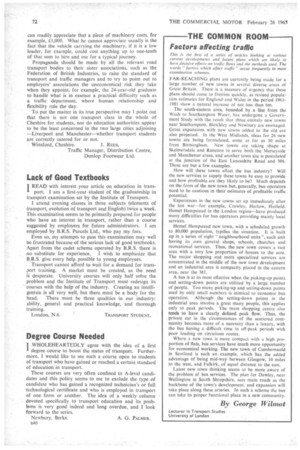THE COMMON ROOM Factors affecting traffic
Page 74

If you've noticed an error in this article please click here to report it so we can fix it.
This is the first of a series of articles looking at various current developments and future plans which are likely to have decisive effects on traffic flows and the methods used. The words "factors' which affect traffic '' occur frequently in most examination schemes.
FAR-REACHING plans are currently being made for a large number of new towns in several diverse areas of Great Britain. There is a measure of urgency that these plans should come to fruition quickly, as revised population estimates for England and Wales in the period 19611981 show a natural increase of not less than 6m.
The south-eastern area, bounded by a line from the Wash to Southampton Water, has undergone a Government Study with the result that three entirely new towns near Southampton, Bletehley and Newbury are envisaged. Great expansions with new towns added to the old are also projected. In the West Midlands, ideas for 26 new towns are being formulated, some as far as 50 miles from Birmingham. New towns are taking shape at Skelmersdale and Runcorn to serve both the Merseyside and Manchester areas, and another town site is postulated at the junction of the East Lancashire Road and M6. These are but a few examples.
How will these towns affect the bus industry? Will the new services to supply these towns be easy to provide and how profitable.are they likely to be? Much depends on the form of the new town hut, generally, bus operators need to be cautious in their estimates of profitable traffic potential.
Experiences in the new towns set up immediately after the last war—for example, Crawley, Harlow, Hatfield, Hemel Hempstead in the London region—have produced many difficulties for bus operators providing mainly local services.
Hemel Hempstead new town, with a scheduled growth to 80,000 population, typifies the situation. It is built up in a series of eight " neighbourhood units", each unit having its own general shops, schools, churches and recreational services. Thus, the new town covers a vast area with a very low proportion of houses to the acre. The major shopping and more specialized services are concentrated in the middle of the new town development and an industrial area is compactly placed in the eastern area, near the MI.
A bus is at its most effective when the picking-up points and setting-down points are utilized by a large number of People. Too many picking-up and setting-down points used by only small numbers is inimical to economic bus operation. Although the setting-down points in the industrial area involve a great many people, this applies only to peak periods. The main shopping centre also tends to have a clearly defined peak flow. Thus, the . private car in the circumstances of the scattered community becomes more of a necessity than a luxury, with the bus having a difficult time in off-peak periods with poor loading on circuitous routes.
Where a new town is more compact with a high proportion of flats, bus services have much more opportunity for economical working. The new town of Cumbernauld in Scotland is such an example, which has the added advantage of being mid-way between Glasgow, 10 miles to the west, and Falkirk, of equal distance to the east.
Latest new town thinking seems to be more aware of the problem of bus services. The plan for Dawley, near Wellington in South Shropshire, sees main roads as the backbone of the town's development, and expansion will take place along these arteries. In such a scheme the bus can take its proper functional place in a new community.
By George Wilmot




















































































































